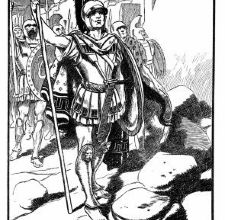Uscommando.com
Weapons of War: Ancient Greek Military Weapons
 From roughly 700 B.C., Greek warfare developed around soldiers known as "hoplites," from the Greek word for "heavy equipment." Foot soldiers grouped into large battle formations known as "phalanxes." Back then, the Greek style of battle involved running forward and crashing into the enemy, so hoplite phalanxes made a fearsome army with their heavy armor and formidable weapons.
From roughly 700 B.C., Greek warfare developed around soldiers known as "hoplites," from the Greek word for "heavy equipment." Foot soldiers grouped into large battle formations known as "phalanxes." Back then, the Greek style of battle involved running forward and crashing into the enemy, so hoplite phalanxes made a fearsome army with their heavy armor and formidable weapons.
Hoplon:
The hoplon was a shield made of wood and covered with leather or bronze. Usually 3 feet in diameter, the hoplon not only shielded the soldier carrying it, but also the soldiers next to him. When the front line of a phalanx all raised their hoplons and charged, they formed a living wall of bronze difficult for an enemy to get through.
Dory
Behind the front row of hoplons, each hoplite carried a spear of 6 1/2 to 10 feet called a "dory" with an iron tip on one end and an iron spike on the other. Fighting began when a phalanx charged with spear tips pointed forwards, propped on the hoplons. Later, if an enemy broke the tip off, the hoplite turned the spear around to fight with the spike instead.
Xiphos
Though the spear was the hoplite's primary weapon, each soldier also carried a short sword called a "xiphos." The xiphos was for close combat, used after the phalanx had broken through enemy ranks. They were leaf-shaped and made of bronze with short, square handles.
Long Range
Hoplite soldiers required money to buy and maintain their bronze-and-leather armor, called "cuirass." Poor men could not afford it, and without armor, fighting on the front lines as a hoplite was suicidal. Thus, poor men trained in archery and stone-slinging, supporting the phalanxes on the front lines. Some cavalrymen, called "hippeus," also trained in archery from horseback.
CLOSE WINDOW
 From roughly 700 B.C., Greek warfare developed around soldiers known as "hoplites," from the Greek word for "heavy equipment." Foot soldiers grouped into large battle formations known as "phalanxes." Back then, the Greek style of battle involved running forward and crashing into the enemy, so hoplite phalanxes made a fearsome army with their heavy armor and formidable weapons.
From roughly 700 B.C., Greek warfare developed around soldiers known as "hoplites," from the Greek word for "heavy equipment." Foot soldiers grouped into large battle formations known as "phalanxes." Back then, the Greek style of battle involved running forward and crashing into the enemy, so hoplite phalanxes made a fearsome army with their heavy armor and formidable weapons.